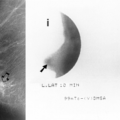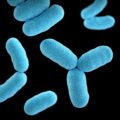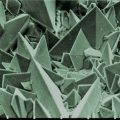In a world where disease states characterized by high levels of inflammation are increasing, more and more scientists are taking a closer look at the connection between oxalate and these conditions.
Oxalate is an inflammatory molecule, that when bound up to minerals in the body, can crystallize and accumulate in organs and tissues. By binding minerals, oxalate can induce nutrient deficiencies impairing many important systems and processes in the body.
High levels of oxalate will also trigger an inflammatory cascade where the NLRP3 inflammasome, which is like our innate immune system’s alarm bell, becomes over-activated increasing NF-kB activity and increasing the release and expression of inflammatory mediators and cytokines like TNF-a, IL-1B and IL-6.
This over-activation can compromise our innate immune system’s ability to jump into action when the next “immune attack” comes along. Whether it is a pathogen-associated molecular pattern (PAMP) triggered by something like influenza A or Covid-19 or a damage-associated molecular pattern (DAMP) triggered by something non-infectious, like uric acid crystals or hyaluronan fragments or oxalate, chronic immune activation precipitated by oxalate will threaten the immune system’s ability to fight the next illness.
The other problem with constant over-activation of the NLRP3 inflammasome is that we now have elevated inflammatory cytokines, which will increase with the next attack, potentially driving us into a cytokine storm syndrome. So, keeping this type of inflammation low is the goal for having a strong immune response when it is needed.
Genes Influencing Oxalate Metabolism
Inborn errors in three particular genes can contribute to faulty glyoxylate metabolism leading to hyperoxaluria – excessive oxalate storage. The glyoxylate pathway is where oxalate metabolism takes place.
- A problem with alanine glyoxylate aminotransferase (AGT/AGXT) will cause someone to convert less glyoxylate to glycine, creating a buildup of glyoxylate which can convert to oxalate. This is characterized as primary hyperoxaluria type 1 (PH1).
- An issue with glyoxylate reductase/hydroxypyruvate reductase (GRHPR) will lead to a lesser conversion of glyoxylate to glycolate and less push by hydroxypyruvate reductase of glyoxylate towards gluconeogenesis, again leaving an accumulation of glyoxylate available to convert. This is referred to as primary hyperoxaluria type 2 (PH2).
- Primary hyperoxaluria type 3 (PH3) involves SNPs in 4-hydroxy-2-oxoglutarate aldolase 1 (HOGA1) and over activity can form excessive glyoxylate from hydroxyproline.
A loss of function mutation in any of AGT, GRHPR or HOGA1 will allow glyoxylate to pool and become available for lactate dehydrogenase (LDH) to convert to oxalate.
Non-genetic Pathways to Poor Oxalate Management
In the Trying Low Oxalates group we see a lot of people without defects in these genes still having issues with oxalate. Here, we have to consider other factors that contribute to elevated oxalate. Some main factors include, but are not limited to:
- Endogenous production (can be caused by both genetic mutations and/or nutrient deficiencies in specific B vitamins)
- Exogenous food sources, particularly in dietary extremes
- Certain supplements that convert or can be degraded to oxalate
- An unhealthy microbiome and estrobolome in general with fewer oxalate degrading microbes and potential hormonal imbalances, often spurred on by past antibiotic use but this is not the only cause
I believe the loss of peroxisome proliferator-activated receptor activity might also play a key role. This family of nuclear receptors are important in many different areas but particularly inflammation and immunity.
What Are Peroxisome Proliferator-Activated Receptors and Why Are They Important?
Peroxisome proliferator-activated receptors (PPARs) are ligand dependent transcription factors that regulate the expression of many genes involved in inflammation, fatty acid metabolism, energy homeostasis and metabolic function. There are a number of ways that PPARs might impact oxalate issues. The glyoxylate cycle itself occurs within the peroxisome. So from a purely mechanical perspective, any derangement of peroxisome function would potentially impact oxalate metabolism.
Additionally, a quick look at studies show that PPARs may alter activity levels of some key genes in oxalate metabolism (AGT, GRHPR). Third, PPARs play a key regulatory role on (intestinal) tight junctions (here, here). Tight junctions help prevent hyper-absorption of oxalate through the gut, while leaky junctions (leaky gut), allow oxalate to disperse into the bloodstream and travel to different tissues and organs where they cause damage.
Lastly, PPARs regulate macrophage polarization and therefore crystal phagocytosis (clearance of oxalate). They also increase antioxidant activity (here, here).
PPAR activity seems directly important to oxalate metabolism due to its control over the genes, tight junctions, macrophages and antioxidant status. A lack or loss of PPAR activity might also affect our glyoxylate cycle and levels, leaving plenty available for conversion to oxalate. Perhaps the lack of PPAR activity plays a role for those who do not have obvious SNPs in the important oxalate genes, yet still wind up in oxalate overload.
PPAR Activation and Inflammation
PPARs play a critical role in inflammation. They have a regulatory effect on both crystal-related enzymes and pro-inflammatory enzymes such as iNOS, metalloproteinase MMP-9 and COX-2, but their main function in inflammation is to promote the inactivation of NF-kB thereby decreasing the production of inflammatory cytokines (here, here). The exact mechanism behind how these are reduced is not clear though. I believe that the reduction of highly inflammatory oxalate in plasma contributes to this. The research seems to support this hypothesis. It is a bit technical, so bear with me.
- Alanine glyoxylate aminotransferase (AGT) is positively regulated by PPAR-alpha (PPAR-a). This means that in absence of sufficient PPAR expression, AGT activity will be low. This allows glyoxylate to accumulate and potentially be converted to oxalate.
- PPAR-a activation is crucial in inducing transcriptional activation of glyoxylate reductase hydroxypyruvate reductase (GRHPR) in mice but in humans GRHPR expression was shown to be PPAR-a independent due to promoter reorganization during primate evolution. (here, here). This means that without proper PPAR activation GRHPR activity will be lower, again allowing glyoxylate to accumulate. However, there is uncertainty if this works the same way in humans as it does mice due to the promoter reorganization that has occurred in man.
- Mice deficient in PPAR-a present higher plasma levels of oxalate and as expected, administration of a PPAR-a ligand reduces plasma oxalate levels.
- PPAR-gamma (PPAR-y) activation suppresses calcium oxalate crystal binding and oxalate-induced oxidative stress.
- Yet oxalate itself impairs PPAR-y expression and phosphorylation creating a very important “negative feedback loop”.
- PPAR-y agonists enhance barrier function through the upregulation of tight junction molecules claudin-1 and -4, occludin, and tricellulin at the transcriptional level, and will thereby be protective against hyper-absorption of oxalate through the “leaky gut”. PPAR expression also leads to a significant increase in tight junction strands, which will create a stronger barrier between the apical and basolateral membrane domains limiting the excess passage of oxalate and other proteins and lipids (here, here).
- Classically activated M1 macrophages (which are inflammatory and cause tissue damage) facilitate renal crystal formation while alternatively activated M2 macrophages (that are anti-inflammatory and focused on tissue repair) suppress it (here, here). Macrophages have an important role in crystal phagocytosis, which is the process where phagocytes engulf and destroy foreign substances, like oxalate. PPARs play a key role in regulating this macrophage polarization to ensure that the anti-inflammatory macrophages are activated and assisting with tissue repair and crystal phagocytosis.
- PPAR-y agonists can regulate TGF-β1 and HGF/c-Met to exert antioxidant effects against hyperoxaluria and alleviate crystal deposition and can exert an antioxidant effect through the PPAR-γ-AKT/STAT3/p38 MAPK-Snail signaling pathway.
Nutrients That Influence PPAR Activity
We know nutrient deficiencies play into oxalate issues so it is not surprising that B vitamins (B1, B2, B3, B5, B6, biotin, folic acid, and B12) activate PPAR-a and PPAR-y.
There are many natural ligands that can activate PPARs, like essential fatty acids and eicosanoids, but as indicated in this study they are required in extremely high concentrations of up to 100 uM for PPAR activation. A quick glance at ctdbase.org reveals that a wide variety of nutrients are capable of activating PPARs, but again, I would guess they would be required in huge pharmacological doses.
A couple notable ligands (but certainly not limited to) are free fatty acids with a preference for long-chain polyunsaturated fatty acids (PUFA’s) like arachidonic acid, alpha linolenic acid, EPA and DHA, linoleic acid, carnitine, alpha tocopherol, various carotenoids, endocannabinoids, PGJ2, leukotriene B4 and more. Ligands worth noting that have inhibitory effects are caffeine. There are other nutrients that have seem to have both activating and inhibitory effects, like zinc and copper.
Beta carotene appears to have both inhibitory and activating effects on PPAR’s depending on concentration, but BCMO1 is also transcriptionally regulated by PPAR-y, so might be worth digging into for anyone with SNP’s there (here, here).
Folic acid appears to have differential effects on PPAR-a and PPAR-y activity, so could be valuable to consider for those with MTHFR SNPs (here, here).
PEA and PPARs
I have wondered how much palmitoylethanolamide (PEA) comes into play. PEA is a fatty acid amide produced endogenously by neurons and glial cells in the central nervous system and also contained in egg yolks, peanuts and soybean. PEA is involved in the neuroprotective mechanisms that are activated following tissue damage and inflammation. In the cell, PEA is hydrolyzed (broken down) by fatty acid amide hydrolase (FAAH). Upregulation of this FAAH gene can cause us to rapidly break down PEA in the cell making it unavailable for its anti-inflammatory and analgesic effects.
In the body, it is produced on demand and acts locally, and its production is increased in areas of inflammation. PEA has been shown to activate both PPAR-a and PPAR-y. In doing so, it regulates inflammation and crystal-related genes and in this way helps to quench inflammation. So, elevated activity of FAAH may work against us with regards to inflammation by too rapidly breaking down this helpful endogenous fatty acid amide.
Genes involved in FAAH activity:
- rs324420 A allele will cause lower and C will cause higher FAAH activity
- rs2295633 G allele will cause likely higher activity
- rs3766246 G allele will cause possibly higher activity
PEA is a ligand for the PPAR nuclear receptors, but it is not clear if it is PEA’s direct effect that is most beneficial or the “entourage effect” that improves PPAR activity. In the entourage effect, PEA competitively inhibits FAAH’s hydrolysis of and provides a sparing effect of anandamide (AEA). AEA is known as the “bliss molecule” as it can bind to cannabinoid receptors, providing an analgesic effect and creating feelings of happiness and wellbeing. AEA is the more potent ligand for the PPAR’s so it is believed PEA’s prevention of AEA breakdown is also important for better PPAR activation.
It is also possible to have mutations in the 3 PPAR’s themselves which can lead to a loss of function, so they may be worth looking at too.
Conditions that Overlap with Oxalate and PPAR Activity
There are some key conditions that have traditionally been recognized as overlapping with oxalate overload. Notably, these include: COPD and respiratory disorders, cystic fibrosis, chronic kidney disease, thyroid disorders, vulvodynia, and autism.
We are also beginning to see that oxalate intersects with many other conditions. Studies show and we have learned through discussions on TLO that there is a clear tie between oxalate and conditions like metabolic syndrome, diabetes, obesity, mast cell activation syndrome, chronic fibromyalgia type pain, mood disorders, fatty acid oxidation issues and more. It seems that dysfunctional PPAR activity is central to most of these, as well.
Inadequate PPAR expression may affect overall oxalate concentrations and allow many of these conditions to develop alongside oxalate overload. This is one of the reasons that inflammation is finally being recognized as a clear contributor to neurological and mood disorders. We know oxalate can also be causative for some of these conditions, so there is a viscous cycle of inflammation that needs to be broken. I hope that factoring in PPAR activity and its effect on oxalate metabolism might be helpful to your own research and health journeys.
In the next article, I will take a closer look at some of the conditions discussed here and how oxalate and the PPARs might both play a role.
We Need Your Help
More people than ever are reading Hormones Matter, a testament to the need for independent voices in health and medicine. We are not funded and accept limited advertising. Unlike many health sites, we don’t force you to purchase a subscription. We believe health information should be open to all. If you read Hormones Matter, like it, please help support it. Contribute now.
Yes, I would like to support Hormones Matter.















